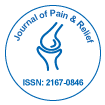Commentary on the glial Cell's Role in Antinociceptive Differential Effects of Oxytocin upon Female and Male Rats
Received: 12-Jul-2023 / Manuscript No. JPAR-23-105660 / Editor assigned: 14-Jul-2023 / PreQC No. JPAR-23-105660 / Reviewed: 28-Jul-2023 / QC No. JPAR-23-105660 / Revised: 04-Aug-2023 / Manuscript No. JPAR-23-105660 / Accepted Date: 13-Jul-2023 / Published Date: 11-Aug-2023 DOI: 10.4172/2476-2024.8.S1.004
Keywords:
Description
The pain hypersensitivity brought on by noxious and benign stimuli typically involved the inflammatory process causing hypersensitivity. Specific medications, especially non-steroidal anti-inflammatory drugs, cannot be used to manage pain in certain patients with systemic disorders. Consequently a complementary therapy is required. In preclinical and clinical trials, oxytocin has proven to be a potent analgesic. The purpose of this study was to examine how Glial cells contribute to oxytocin-induced analgesia and how sex affects this response. The study showed that a sexual dimorphism involving spinal glia activation determines oxytocin-mediated analgesia. The study concluded that Oxytocin could be used preferentially to treat pain in men with a high inflammatory component, since treating pain in men and women requires distinct approaches.
Dissimilarity between pain and related responses is observed if we compare males and females [1]. Females display more sensibility and lengthy temporal summation to pain compared to males, and males present relatively more pain modulation [2]. Riveting attention has been focused on the glial cells' role in pain and maintenance processes due to their different distribution along the nervous system, their sexual hormones influence, and their reactivity to injuries [3]. Moreover, the literature claims that females required more important doses to reach an analgesic effect [4,5]. In this context, it is claimed that new molecules and doses are related to sex.
In this regard, beyond the well-known function of the neuropeptide oxytocin upon pregnancy, maternal and social behavior in the last years it has been consistently shown that oxytocin at spinal dorsal horn level (the first relay at central nervous system where the incoming peripheral nociceptive stimuli can be modulated) block incoming nociceptive input. Briefly, electrophysiological, behavioral, and molecular data support the contention that this antinociceptive effect is mediated by activation of the Oxytocin Receptor (OTR). Accordingly, clinical data support the potential use of this neuropeptide as an analgesic (REFS). However, dimorphic sexual differences in the effect of this neuropeptide have also been observed (i.e., females are less prone to the oxytocin’s antinociceptive effect), and to reach similar effects preclinical data suggest that higher doses of this neuropeptide is required to obtain a similar antinociceptive effect in females.
Study by Abarca ABS, et al. describes the oxytocin analgesic relationship with glial cells. At this point, it is essential to highlight the importance of different doses to treat similar level of pains in males or females. The problem is that in the medical practice the same doses of analgesic in males and females is the standard, but we need to emphasize that physiological differences exist [6].
Oxytocin is a hormone that has a potent analgesic effect in experimental, preclinical, and clinical studies. Oxytocin also showed a dimorphic sexual effect, and females showed a lower antinociceptive effect [6-9]. Nevertheless, the previous works used the same dose to compare male vs female’s effects. Also, a well-established relationship in dose-response was rationalized and relating a more important analgesic effect with higher doses due to the different pathways activating Gq or Gi proteins to trigger the oxytocin receptor (4-7). This commentary was focused on the experimental rat model study by Abarca ABS, et al. to analyze the difference in the analgesic response to Oxytocin between male and female rats in terms of behavioural, electrophysiological and molecular events [6]. The study emphasized that hypersensitivity was longer in female rats and concluded that spinal oxytocin substantially prevented induced hypersensitivity in male rats involving spinal Glial cells activation.
References
- Pieretti S, Giannuario AD, Giovannandrea RD, Marzoli F, Piccaro G, et al. (2016) Gender differences in pain and its relief. Ann Ist Super Sanita 52:184-189.
[Crossref] [Google Scholar] [PubMed]
- Bartley EJ, Fillingim RB (2013) Sex differences in pain: A brief review of clinical and experimental findings. Br J Anaesth 111:52-58.
[Crossref] [Google Scholar] [PubMed]
- Athnaiel O, Cantillo S, Paredes S, Knezevic NN (2023) The role of sex hormones in pain-related conditions. Int J Mol Sci 24: 1866-1873.
- Chowen JA, Segura LMG (2021) Role of glial cells in the generation of sex differences in neurodegenerative diseases and brain aging. Mech Ageing Dev 196: 142-173.
[Crossref] [Google Scholar] [PubMed]
- Cepeda MS, Carr DB (2003) Women experience more pain and require more morphine than men to achieve a similar degree of analgesia. Anesth Analg 97:1464-1468.
[Crossref] [Google Scholar] [PubMed]
- Abarca ABS, Cuevas FV, Gallardo AG, Lorenzana GM, Hernández AG, et al. (2022) the glial cell’s role in antinociceptive differential effects of oxytocin upon female and male rats. Eur J Pain 26:796-810.
[Crossref] [Google Scholar] [PubMed]
- Chini B, Verhage M, Grinevich V (2017) the action radius of oxytocin release in the mammalian cns: from single vesicles to behavior. Trends Pharmacol Sci 38:982-99.
[Crossref] [Google Scholar] [PubMed]
- Zúñiga AEM, Lorenzana GM, Lara MC, Hernández AG (2021) in vivo dissection of two intracellular pathways involved in the spinal oxytocin-induced antinociception in the rat. ACS Chem. Neurosci. 12:3140-3147.
- Chow LH, Chen YH, WuWC, Chang EP, Huang EY (2016) sex difference in oxytocin-induced anti-hyperalgesia at the spinal level in rats with intraplantar carrageenan-induced inflammation. PloS One 11: 162-218.
Share This Article
Recommended Conferences
42nd Global Conference on Nursing Care & Patient Safety
Toronto, CanadaRecommended Journals
Open Access Journals
Article Tools
Article Usage
- Total views: 850
- [From(publication date): 0-2023 - Apr 06, 2025]
- Breakdown by view type
- HTML page views: 630
- PDF downloads: 220
